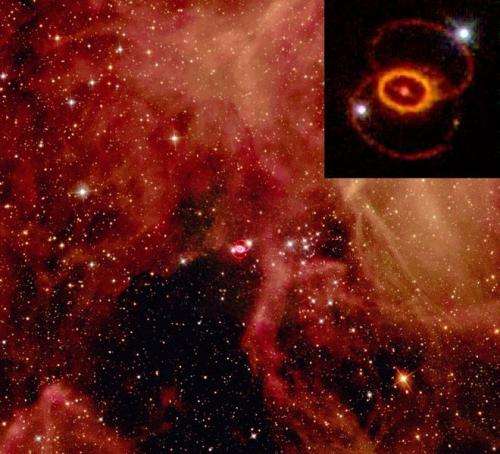Fewer exploding stars potential predictor of global warming

(Phys.org)—One of the universe's greatest unexplained mysteries – why stars explode – could be explained by a particle similar to the Higgs boson. The theory developed by University of Aberdeen astrophysicist, Dr Charles Wang, will be tested at CERN, the European Organization for Nuclear Research, in December and was announced at the British Science Festival today.
If proven, it could also help in the prediction of global warming in the future, given the impact star explosions have on the Earth's atmosphere.
Dr Wang said: "There is a direct correlation between star explosions and the temperature of the Earth's atmosphere.
"When a star explodes a massive amount of cosmic rays enter the atmosphere affecting the weather in space by making it cloudier. "More clouds in space leads to the Earth's atmosphere being cooler. "Global warming could therefore be connected to stars exploding in our skies less frequently.
"We cannot control the explosion of stars, but if we can understand the process by which it happens we could potentially better predict when and where these explosions will take place and as a result make predictions on how the Earth's climate could change in the decades to come."
On average one star explodes every year in all the galaxies – these events are the most powerful to take place in the universe, second only to the big bang. Two types of starbursts - also known as supernova explosions - take place in our skies.
One is where two stars merge which results in a burst of energy – the other type, involving the collapse of a single star, remains one of the greatest outstanding mysteries of the universe, unsolved by any known methods of using the current laws of physics.
Dr Wang's theory suggests an entirely new type of particle – similar to the Higgs boson – could be responsible for this second type of explosion.
He continued: "It is known that stars are like giant nuclear power plants, perpetually converting one form of energy – hydrogen atoms - into another – helium atoms.
"This process is what initially keeps stars in the sky – the heat generated in the conversion maintains the pressure which stops stars becoming too heavy.
"But once helium atoms form in the star they then convert into heavier elements such as oxygen, carbon and irons.
"A massive amount of energy is released in the central part of the star when helium atoms convert into these elements.
"It was once thought that this build up of energy is what causes the central part of the star to become so powerful that it bursts out of its outer shell. But decades ago this theory was disproven when it was shown that this conversion would not result in a large enough energy force to cause the explosion.
"My theory is that a scalar particle – one of the most elementary types of particles in the universe and similar to the Higgs boson – is at work within these stars and responsible for the additional energy which causes the explosion this take place."
Provided by University of Aberdeen



















